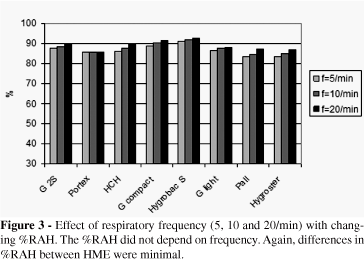OBJECTIVES: To evaluate and compare the efficiency of humidification in available heat and moisture exchanger models under conditions of varying tidal volume, respiratory rate, and flow rate. INTRODUCTION: Inspired gases are routinely preconditioned by heat and moisture exchangers to provide a heat and water content similar to that provided normally by the nose and upper airways. The absolute humidity of air retrieved from and returned to the ventilated patient is an important measurable outcome of the heat and moisture exchangers' humidifying performance. METHODS: Eight different heat and moisture exchangers were studied using a respiratory system analog. The system included a heated chamber (acrylic glass, maintained at 37°C), a preserved swine lung, a hygrometer, circuitry and a ventilator. Humidity and temperature levels were measured using eight distinct interposed heat and moisture exchangers given different tidal volumes, respiratory frequencies and flow-rate conditions. Recovery of absolute humidity (%RAH) was calculated for each setting. RESULTS: Increasing tidal volumes led to a reduction in %RAH for all heat and moisture exchangers while no significant effect was demonstrated in the context of varying respiratory rate or inspiratory flow. CONCLUSIONS: Our data indicate that heat and moisture exchangers are more efficient when used with low tidal volume ventilation. The roles of flow and respiratory rate were of lesser importance, suggesting that their adjustment has a less significant effect on the performance of heat and moisture exchangers.
Heat and moisture exchangers; Humidity; Temperature; Mechanical ventilation





